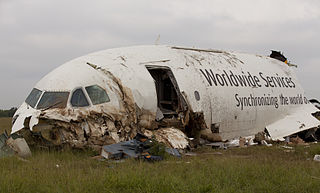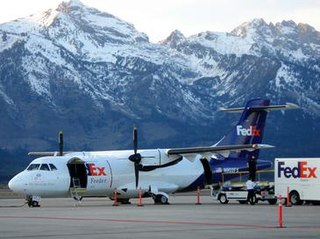Northwest Airlink was the brand name of Northwest Airlines' regional airline service, which flew turboprop and regional jet aircraft from Northwest's domestic hubs in Minneapolis, Detroit, and Memphis. Service was primarily to small-to-medium-sized cities and towns where larger aircraft might not be economical to operate and also to larger markets to either provide additional capacity or more frequent flights than could be justified using mainline aircraft. Beginning in July 2009, the Northwest Airlink trade name was phased out, and replaced by the Delta Connection trade name for Delta Air Lines as part of the Delta/Northwest merger.

Kirksville Regional Airport is four miles south of Kirksville, Missouri, on the west side of US highway 63. One airline schedules passenger flights, subsidized by the Essential Air Service program.

Pilot error generally refers to an accident in which an action or decision made by the pilot was the cause or a contributing factor that led to the accident, but also includes the pilot's failure to make a correct decision or take proper action. Errors are intentional actions that fail to achieve their intended outcomes. The Chicago Convention defines the term "accident" as "an occurrence associated with the operation of an aircraft [...] in which [...] a person is fatally or seriously injured [...] except when the injuries are [...] inflicted by other persons." Hence the definition of "pilot error" does not include deliberate crashing.
RegionsAir was a 14 CFR Part 121 regional airline based out of the Smyrna Airport in Smyrna, Tennessee, USA. The hub airports for RegionsAir were Lambert-St. Louis International Airport (STL) and Cleveland Hopkins International Airport (CLE).

Mohawk Airlines Flight 405, a Fairchild Hiller FH-227 twin-engine turboprop airliner registered N7818M, was a domestic scheduled passenger flight operated by Mohawk Airlines that crashed into a house within the city limits of Albany, New York, on March 3, 1972, on final approach to Albany County Airport, New York, killing 17 people. The intended destination airport lies in the suburban Town of Colonie, about 4 miles north of the crash site.
Downeast Airlines was a commuter airline based in Rockland, Maine, from 1960 to June 1, 2007, when it was acquired by Maine Atlantic Aviation, an arm of the Jordache Enterprises conglomerate. While the airline was closed, Downeast Air remains a fixed-base operator at its former home airfield.

Colgan Air Flight 3407 was a scheduled passenger flight from Newark, New Jersey, USA to Buffalo, New York, USA on February 12, 2009. Colgan Air staffed and maintained the aircraft used on the flight that was scheduled, marketed and sold by Continental Airlines under its Continental Connection brand. The aircraft, a Bombardier Q400, entered an aerodynamic stall from which it did not recover and crashed into a house at 6038 Long Street in Clarence Center, New York at 10:17 pm EST, killing all 49 passengers and crew on board, as well as one person inside the house.

Korean Air Flight 801 was a scheduled international passenger flight operated by Korean Air, from Gimpo International Airport, Seoul to Antonio B. Won Pat International Airport, Guam. On August 6, 1997, the Boeing 747-300 operating the flight crashed on Bijia Peak, south of Nimitz Hill, in Asan-Maina, Guam, while on approach to Antonio B. Won Pat International Airport, in the United States territory of Guam, killing 229 of the 254 people aboard.

The British Aerospace Jetstream is a small twin turboprop airliner, with a pressurised fuselage, developed as the Jetstream 31 from the earlier Handley Page Jetstream. A larger version of the Jetstream was also manufactured, the British Aerospace Jetstream 41.

United Express Flight 6291 was a regularly scheduled United Express flight from Dulles International Airport near Washington, D.C. to Port Columbus International Airport in Columbus, Ohio. It was a service operated by Atlantic Coast Airlines on behalf of United Express.

Northwest Airlink Flight 5719 was a flight from Minneapolis-Saint Paul International Airport to International Falls Airport in International Falls, Minnesota with a scheduled intermediate stop at Chisholm-Hibbing Airport in Hibbing, Minnesota. On December 1, 1993, the Jetstream 31, operated by Express Airlines I as Northwest Airlink, collided with a group of trees in a forest during final approach to Hibbing, and crashed into two ridges northwest of the airport, killing all sixteen passengers and the two pilots on board.

Allegheny Airlines Flight 736 was a regularly scheduled flight that crashed while attempting to land at Bradford Regional Airport in Bradford, Pennsylvania on December 24, 1968. 20 of the 47 occupants on board were killed.

UPS Airlines Flight 1354 (5X1354/UPS1354) was a scheduled cargo flight from Louisville, Kentucky, to Birmingham, Alabama. On August 14, 2013, the Airbus A300 flying the route crashed and burst into flames short of the runway on approach to Birmingham–Shuttlesworth International Airport. Both pilots were pronounced dead at the scene of the crash. They were the only people aboard the aircraft. It was the second fatal air crash for UPS Airlines.

Flagship Airlines Flight 3379 was a scheduled flight under the American Eagle branding from Piedmont Triad International Airport to Raleigh–Durham International Airport during which a British Aerospace Jetstream crashed while executing a missed approach to the Raleigh–Durham International Airport on the evening of Tuesday, December 13, 1994. The two pilots and 13 passengers died in the crash; five passengers survived with serious injuries.

TransAsia Airways Flight 222 was a scheduled domestic passenger flight operated by TransAsia Airways from Kaohsiung, Taiwan, to Magong, Penghu Island. On 23 July 2014, the ATR 72-500 twin turboprop operating the route crashed into buildings during approach to land in bad weather at Magong Airport. Among the 58 people on board, only 10 survived.

Downeast Airlines Flight 46 was a scheduled airline service in the United States from Boston's Logan International Airport to Rockland, Maine operated by Downeast Airlines. On May 30, 1979 a de Havilland Canada DHC-6 Twin Otter operating the flight crashed during a nonprecision approach to Rockland's Knox County Regional Airport. All but one of the 18 people on board were killed. The cause of the accident was controlled flight into terrain (CFIT) after the failure of the flight crew to stop the aircraft's descent below the minimum descent altitude for the non-precision approach at Knox County airport. The investigation into the accident looked into the airline's corporate culture as a contributing factor to the crash; this was the first time an investigation took this approach to an air crash.

The International Civil Aviation Organization (ICAO) defines fatigue as "A physiological state of reduced mental or physical performance capability resulting from sleep loss or extended wakefulness, circadian phase, or workload." The phenomenon places great risk on the crew and passengers of an airplane because it significantly increases the chance of pilot error. Fatigue is particularly prevalent among pilots because of "unpredictable work hours, long duty periods, circadian disruption, and insufficient sleep". These factors can occur together to produce a combination of sleep deprivation, circadian rhythm effects, and 'time-on task' fatigue. Regulators attempt to mitigate fatigue by limiting the number of hours pilots are allowed to fly over varying periods of time.

On May 21, 2000, a British Aerospace BAe-3101 Jetstream 3101 operated by East Coast Aviation Services crashed into mountainous terrain in Bear Creek Township, Wilkes-Barre, Pennsylvania. The plane was carrying 17 professional gamblers returning home from Caesar's Palace Casino in Atlantic City, New Jersey, along with 2 crew members. It was chartered by Caesar's Palace. All 19 passengers and crews on board were killed on impact. This accident, alongside the accident of Aerocaribe Flight 7831 were the accidents with the most fatalities involving the Jetstream 3101 airliner.

Empire Airlines Flight 8284 was a cargo flight operated by Empire Airlines for FedEx Feeder from Fort Worth Alliance Airport to Lubbock Preston Smith International Airport, Texas. On January 27, 2009, it crashed on final approach to its destination. Both crew members survived with minor injuries but the aircraft was written off.


















